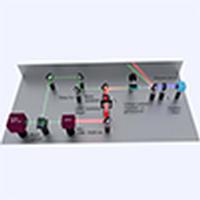当前位置:
X-MOL 学术
›
Adv. Opt. Photon.
›
论文详情
Our official English website, www.x-mol.net, welcomes your
feedback! (Note: you will need to create a separate account there.)
Parametric upconversion imaging and its applications
Advances in Optics and Photonics ( IF 25.2 ) Pub Date : 2019-12-18 , DOI: 10.1364/aop.11.000952 Ajanta Barh , Peter John Rodrigo , Lichun Meng , Christian Pedersen , Peter Tidemand-Lichtenberg
Advances in Optics and Photonics ( IF 25.2 ) Pub Date : 2019-12-18 , DOI: 10.1364/aop.11.000952 Ajanta Barh , Peter John Rodrigo , Lichun Meng , Christian Pedersen , Peter Tidemand-Lichtenberg

|
This paper provides an extensive survey of nonlinear parametric upconversion infrared (IR) imaging, from its origin to date. Upconversion imaging is a successful innovative technique for IR imaging in terms of sensitivity, speed, and noise performance. In this approach, the IR image is frequency upconverted to form a visible/near-IR image through parametric three-wave mixing followed by detection using a silicon-based detector or camera. In 1968, Midwinter first demonstrated upconversion imaging from short-wave-IR (1.6 μm) to visible (484 nm) wavelength using a bulk lithium niobate crystal. This technique quickly gained interest, and several other groups demonstrated upconversion imaging further into the mid- and far-IR with significantly improved quantum efficiency. Although a few excellent reviews on upconversion imaging were published in the early 1970s, the rapid progress in recent years merits an updated comprehensive review. The topic includes linear imaging, nonlinear optics, and laser science and has shown diverse applications. The scope of this article is to provide in-depth knowledge of upconversion imaging theory. An overview of different phase matching conditions for the parametric process and the sensitivity of the upconversion detection system are discussed. Furthermore, different design considerations and optimization schemes are outlined for application-specific upconversion imaging. The article comprises a historical perspective of the technique, its most recent technological advances, specific outstanding issues, and some cutting-edge applications of upconversion in IR imaging.
中文翻译:

参数上转换成像及其应用
本文对非线性参数上转换红外 (IR) 成像进行了广泛的调查,从其起源至今。在灵敏度、速度和噪声性能方面,上转换成像是一种成功的红外成像创新技术。在这种方法中,红外图像通过参数三波混合进行频率上转换以形成可见光/近红外图像,然后使用硅基探测器或相机进行检测。1968 年,Midwinter 首次展示了使用块状铌酸锂晶体从短波红外 (1.6 μm) 到可见光 (484 nm) 波长的上转换成像。这项技术很快引起了人们的兴趣,其他几个小组展示了进一步进入中红外和远红外的上转换成像,并显着提高了量子效率。尽管在 1970 年代初期发表了一些关于上转换成像的优秀评论,但近年来的快速进展值得更新的全面评论。该主题包括线性成像、非线性光学和激光科学,并已显示出多种应用。本文的范围是提供上转换成像理论的深入知识。讨论了参数过程的不同相位匹配条件的概述和上变频检测系统的灵敏度。此外,还概述了针对特定应用的上转换成像的不同设计考虑和优化方案。文章包括该技术的历史视角、其最新的技术进步、具体的突出问题以及上转换在红外成像中的一些前沿应用。近年来的快速进展值得更新的全面审查。该主题包括线性成像、非线性光学和激光科学,并已显示出多种应用。本文的范围是提供上转换成像理论的深入知识。讨论了参数过程的不同相位匹配条件的概述和上变频检测系统的灵敏度。此外,还概述了针对特定应用的上转换成像的不同设计考虑和优化方案。文章包括该技术的历史视角、其最新的技术进步、具体的突出问题以及上转换在红外成像中的一些前沿应用。近年来的快速进展值得更新的全面审查。该主题包括线性成像、非线性光学和激光科学,并已显示出多种应用。本文的范围是提供上转换成像理论的深入知识。讨论了参数过程的不同相位匹配条件的概述和上变频检测系统的灵敏度。此外,还概述了针对特定应用的上转换成像的不同设计考虑和优化方案。文章包括该技术的历史视角、其最新的技术进步、具体的突出问题以及上转换在红外成像中的一些前沿应用。非线性光学和激光科学并已显示出多种应用。本文的范围是提供上转换成像理论的深入知识。讨论了参数过程的不同相位匹配条件的概述和上变频检测系统的灵敏度。此外,还概述了针对特定应用的上转换成像的不同设计考虑和优化方案。文章包括该技术的历史视角、其最新的技术进步、具体的突出问题以及上转换在红外成像中的一些前沿应用。非线性光学和激光科学并已显示出多种应用。本文的范围是提供上转换成像理论的深入知识。讨论了参数过程的不同相位匹配条件的概述和上变频检测系统的灵敏度。此外,还概述了针对特定应用的上转换成像的不同设计考虑和优化方案。文章包括该技术的历史视角、其最新的技术进步、具体的突出问题以及上转换在红外成像中的一些前沿应用。讨论了参数过程的不同相位匹配条件的概述和上变频检测系统的灵敏度。此外,还概述了针对特定应用的上转换成像的不同设计考虑和优化方案。文章包括该技术的历史视角、其最新的技术进步、具体的突出问题以及上转换在红外成像中的一些前沿应用。讨论了参数过程的不同相位匹配条件的概述和上变频检测系统的灵敏度。此外,还概述了针对特定应用的上转换成像的不同设计考虑和优化方案。文章包括该技术的历史视角、其最新的技术进步、具体的突出问题以及上转换在红外成像中的一些前沿应用。
更新日期:2019-12-18
中文翻译:

参数上转换成像及其应用
本文对非线性参数上转换红外 (IR) 成像进行了广泛的调查,从其起源至今。在灵敏度、速度和噪声性能方面,上转换成像是一种成功的红外成像创新技术。在这种方法中,红外图像通过参数三波混合进行频率上转换以形成可见光/近红外图像,然后使用硅基探测器或相机进行检测。1968 年,Midwinter 首次展示了使用块状铌酸锂晶体从短波红外 (1.6 μm) 到可见光 (484 nm) 波长的上转换成像。这项技术很快引起了人们的兴趣,其他几个小组展示了进一步进入中红外和远红外的上转换成像,并显着提高了量子效率。尽管在 1970 年代初期发表了一些关于上转换成像的优秀评论,但近年来的快速进展值得更新的全面评论。该主题包括线性成像、非线性光学和激光科学,并已显示出多种应用。本文的范围是提供上转换成像理论的深入知识。讨论了参数过程的不同相位匹配条件的概述和上变频检测系统的灵敏度。此外,还概述了针对特定应用的上转换成像的不同设计考虑和优化方案。文章包括该技术的历史视角、其最新的技术进步、具体的突出问题以及上转换在红外成像中的一些前沿应用。近年来的快速进展值得更新的全面审查。该主题包括线性成像、非线性光学和激光科学,并已显示出多种应用。本文的范围是提供上转换成像理论的深入知识。讨论了参数过程的不同相位匹配条件的概述和上变频检测系统的灵敏度。此外,还概述了针对特定应用的上转换成像的不同设计考虑和优化方案。文章包括该技术的历史视角、其最新的技术进步、具体的突出问题以及上转换在红外成像中的一些前沿应用。近年来的快速进展值得更新的全面审查。该主题包括线性成像、非线性光学和激光科学,并已显示出多种应用。本文的范围是提供上转换成像理论的深入知识。讨论了参数过程的不同相位匹配条件的概述和上变频检测系统的灵敏度。此外,还概述了针对特定应用的上转换成像的不同设计考虑和优化方案。文章包括该技术的历史视角、其最新的技术进步、具体的突出问题以及上转换在红外成像中的一些前沿应用。非线性光学和激光科学并已显示出多种应用。本文的范围是提供上转换成像理论的深入知识。讨论了参数过程的不同相位匹配条件的概述和上变频检测系统的灵敏度。此外,还概述了针对特定应用的上转换成像的不同设计考虑和优化方案。文章包括该技术的历史视角、其最新的技术进步、具体的突出问题以及上转换在红外成像中的一些前沿应用。非线性光学和激光科学并已显示出多种应用。本文的范围是提供上转换成像理论的深入知识。讨论了参数过程的不同相位匹配条件的概述和上变频检测系统的灵敏度。此外,还概述了针对特定应用的上转换成像的不同设计考虑和优化方案。文章包括该技术的历史视角、其最新的技术进步、具体的突出问题以及上转换在红外成像中的一些前沿应用。讨论了参数过程的不同相位匹配条件的概述和上变频检测系统的灵敏度。此外,还概述了针对特定应用的上转换成像的不同设计考虑和优化方案。文章包括该技术的历史视角、其最新的技术进步、具体的突出问题以及上转换在红外成像中的一些前沿应用。讨论了参数过程的不同相位匹配条件的概述和上变频检测系统的灵敏度。此外,还概述了针对特定应用的上转换成像的不同设计考虑和优化方案。文章包括该技术的历史视角、其最新的技术进步、具体的突出问题以及上转换在红外成像中的一些前沿应用。











































 京公网安备 11010802027423号
京公网安备 11010802027423号